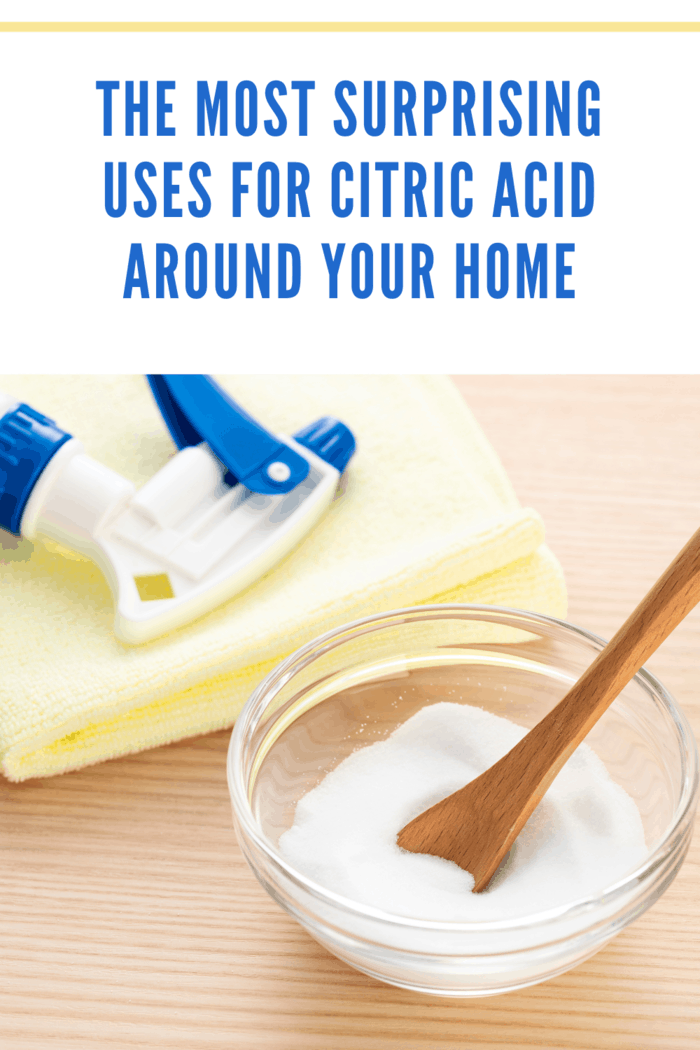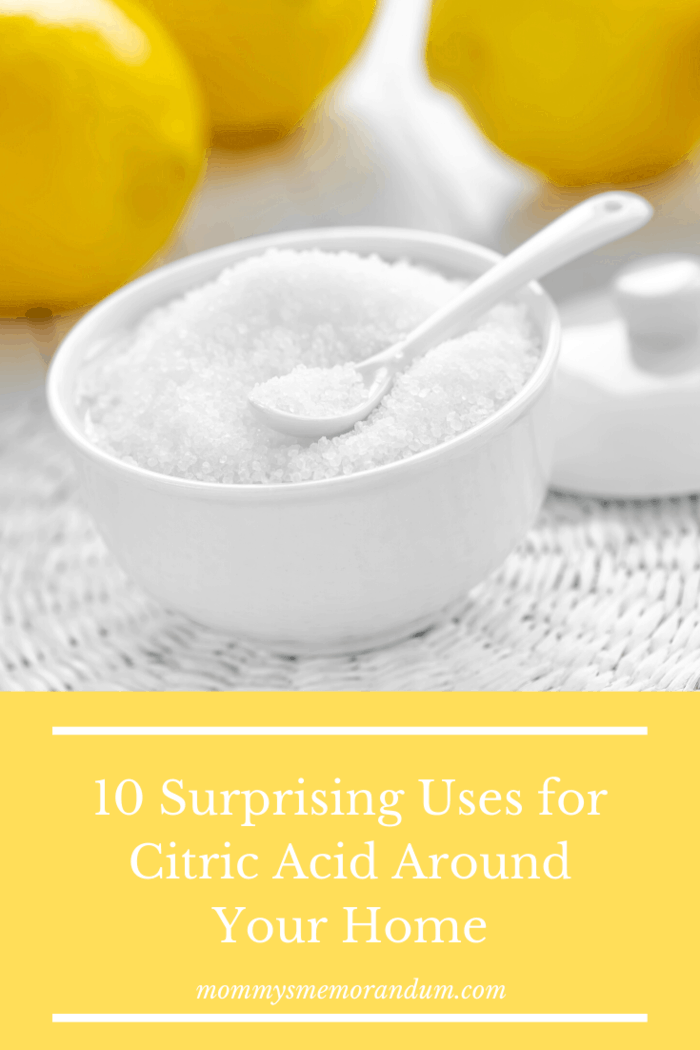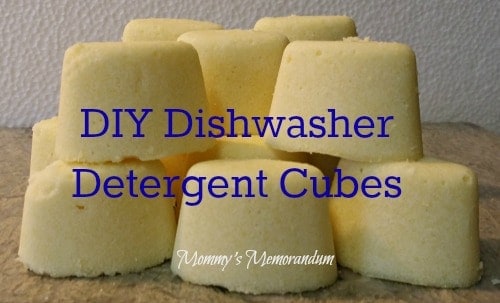How To Clean With Citric Acid
Post Views: 230
Jump to Recipe
Chemical-laden household cleaners can do a number on your health and the health of your loved ones.
Many of these products are responsible for breathing problems, irritating the eyes and throat, or even producing cancer later in life.
Looking for a way to clean naturally is preferable to avoid any illnesses.
You can make your cleaners, and save plenty of money while reducing the number of chemicals brought into your home.
Citric acid is a type of natural cleaner that works and is easily incorporated into your cleaning routine.
As with most organic acids, citric acid is a weak organic acid, with a pH level between 3 and 6.
Read on to discover the uses for citric acid and why this powerful cleaner deserves a spot on in your cleaning caddy.

What is Citric Acid?
Citric acid was discovered in the 8th century, by an Islamic alchemist, Jabir Ibn Hayyan.
A Swedish researcher, Carl Wilhelm Scheele, in 1784, was the first to derive citric acid from lemon juice.
Citric acid occurs naturally in citrus fruits like lemons, limes, grapefruits, and oranges.
It is also found in pineapples, tomatoes, broccoli, carrots, some pepper variations, and berries (with the exception of blueberries).
It's an acid compound that is colorless and odorless and is responsible for the tarty, sour taste in citrus fruits.
While citric acid is found in a variety of fruits, it's also artificially manufactured and used in other commercial products.
Manufactured citric acid is one of the most common food additives in the world.
Read the back of any label, and you'll likely find artificial citric acid listed in the ingredients, which usually means it's used as a natural preservative.
As well, you may find citric acid in processed and packaged foods such as ice cream, including sorbets, soft drinks, fruit juice, those sour flavor gummies your kids love.
Citric acid is also added to canned and jarred foods to help prevent botulism, a rare but serious illness caused by the toxin-producingClostridium botulinum bacteria.
The citric acid listed in the ingredients of foods and supplements is manufactured —it is not the citric acid naturally found in citrus fruits.
The U.S. Food and Drug Administration (FDA) states that citric acid is generally recognized as safe (GRAS) as a direct food additive.
Citric acid use reaches beyond food products and food preservation.
You'll likely find it in wine, (to reduce low acidity and improve taste), skincare and beauty products, hair products, hand soaps, bath bombs, personal care products, and even supplements.
In cosmetics and personal care products, the use of citric acid is used as a preservative, to balance PH levels and help minimize fine lines, as a skin brightener, and to correct dark spots.
Ingredients in lipsticks, soap, and detergents may list Sodium citrate, a salt of citric acid.
The purpose of its inclusion is generally to balance the pH in some products.
It's also used to stabilize or preserve medicines and as a disinfectant against viruses and bacteria.
Citric acid — in the form of potassium citrate — prevents new kidney stone formation and breaks apart those already formed.
Kidney stones are often treated with citric acid as potassium citrate. However, consuming foods high in this natural acid — like citrus fruits — can offer similar stone-preventing benefits.
Where Does Citric Acid Come From?
Hold on to your taste buds, until the early 1900s citric acid was derived as it was back in 1784, from lemons, then researchers made a discovery–black mold.
Black mold efficiently converts sugars into citric acid and its fermentation also is generally recognized as safe by FDA under its Federal Food, Drug, and Cosmetic Act.
Approximately 99 percent of the world's production of manufactured citric acid powder is developed from the Aspergillus niger fungus, also known as black mold.

Citric Acid to Clean?
The naturally occurring citric acid is perfect for making natural cleaning products to clean your home.
It tackles soap scum, removes hard water build-up, stains, and even rust.
It works great to remove coffee stains, tea stains, yellowing and browning discolorations as well as water and urine stains.
Citric acid also combats bacteria and mold without harmful chemicals, leaving you feeling safer in your own home.
Citric acid can be used on metal, however, to prevent rust, the metal should be rinsed well and dried after cleaning.
10 Common Uses of Citric Acid
Are you curious about how you can use citric acid to clean?
The good news is there are many ways to clean with citric acid around your home!
Here are ten citric acid uses you need to know.
1. Soap Scum
One of the highlights of citric acid is that it does a fantastic job doing away with soap scum.
Its abrasive powers work to eliminate soap scum and hard water stains while protecting your health and your furnishings.
Clean those shower doors with ease: use the above portions 6:1 and put in a spray bottle–spray and wipe.
2. Laundry
Citric acid is a common ingredient in laundry detergents.
Citric acid works well as a fabric softener because it balances the pH of the laundry detergent (home-ec101 has an article that goes into this more.), especially if it's a powder form.
When clothing emerges from the washer, they're alkaline.
Adding citric acid to your wash improves the pH and keeps your clothes balanced.
Add some to your load of laundry for softer water, reducing the amount of soap needed.
3. All-Purpose Cleaner
Ready to clean your toilet bowl, counters, and almost every other surface in your home in a non-toxic way?
A solution made with citric acid is the way to go.
Mix up a solution and add to a spray bottle then feel free to spray it almost anywhere (except a few places – see below), and take care of germs and grime.
It even works to repel dust!
Eco-Friendly household cleaner: 6 parts water with 1 part citric acid. Just spray and wipe.

4. Stainless Steel and Copper
Despite its acidity, citric acid can be used to clean stainless steel.
It leaves behind a polished, clean look without using dangerous chemicals.
Use 2 oz. citric acid to 1 gallon of water and rub on copper. Let sit overnight and then use steel wool for a beautifully clean
5. Lime and Rust
Lime and rust are a challenge to get rid of, but they're no match for citric acid.
It won't remove any of the finish and is less abrasive than other cleaners.
It typically takes a bit longer and requires more elbow grease, but it's preferable to harsh chemicals.

6. Dishwasher Detergent
Citric acid is safe for the dishwasher and can be used as an eco-friendly dishwasher detergent or for cleaning your dishwasher, plastic, or stainless steel.
There's no residue left behind on dishes, and the water isn't contaminated with chemicals, so there's a less negative impact on the environment.
Here's how to make dishwasher detergent cubes with citric acid.
Make dishes and glassware sparkle: put some citric acid in the dishwasher bottom to prevent spots on dishes.

7. Window Cleaner
Yes, citric acid gets your windows sparkling!
Cleaning the windows is often an excellent chore for kids.
If you have kids who love helping clean around the home, there's no need to worry about the ingredients when you use citric acid.
8. Stain Remover
Getting a stain on your favorite shirt or pants is a huge disappointment.
But citric acid can help!
When it comes to stain, citric acid works similarly to bleach, working to eliminate unsightly stains and even odors.
9. Bathroom Cleaner
No one wants to clean the bathroom, but it needs to be done.
Using citric acid makes it more enjoyable because you're not filling the room with the smell of toxic chemicals.
It tackles stains and build-up both in your toilet and on your tile, leaving your bathroom smelling fresh.
10. Coffee Makers
Who doesn't love their morning cup of coffee?
But forgetting to clean the coffee maker and coffee pot leaves your morning coffee tasting more like the chemical build-up.
Citric acid works to break up mineral deposits p that accumulates over time in your coffee maker.

Fun Fact: Citrate — a closely related molecule of citric acid — is the first molecule that forms during a process called the citric acid cycle.
Also known as the tricarboxylic acid (TCA) or Krebs cycle, these chemical reactions in your body help transform food into usable energy
Bonus!
Make your own wine slushies and add citric acid for a boost of tang and tartness.
Easy Homemade Wine Slushie Mix with Citric Acid Recipe
1 to 1 ½ cups sugar (dry wine will require the larger amount)
1 ½ teaspoon citric acid
1 (750 ml) bottle of wine
3 cups of water
Easy Homemade Wine Slushie Mix with Citric Acid directions
Measure sugar and citric acid into a food processor or blender
Run the food processor/blender for a minute or two, to finely process the sugar and evenly distribute the ingredients.
Pour powdered mix into a baggie or airtight container until ready to use.
To make wine slush:
Add citric acid and sugar mix into a 1-gallon freezer bag (or a large bowl).
Add one 750 ml bottle of wine, and 3 cups of water.
Stir/shake well.
Freeze for at least 3 hours before serving in glasses of your choice.
Freeze the mixture for a bit longer, stirring/shaking every 30 minutes or so, to produce a finer sorbet style dessert.

How to make your own Citric Acid mask:
1 tablespoon of Citric Acid
1/2 tablespoon filtered water or 100% pure aloe vera gel.
Directions:
Apply to face and leave on for about 10-15 min. Avoid directly under the eyes.
Remove with a soft warm washcloth.
I'm Citric Acid Convert. Where Can I Buy It?
You're in luck!
Citric acid is widely available in many forms.
It comes in a powder or a liquid, which you can use in homemade cleaners or on its own.
There are also pre-made products that have citric acid in them – like all-purpose sprays and detergents – which makes using citric acid very convenient.
Something You Shouldn't Clean With Citric Acid
While citric acid is favorable for nearly every surface and situation, you should avoid cleaning marble, brass, stone, and other antiques.
Doing so could cause more harm to these metals.
Are You Ready to Clean With Citric Acid?
Once you understand the capabilities of citric acid and see the results, making the switch is easy.
The uses for citric acid are almost endless and provide a safe and effective cleaner for your home and family.
Are you curious about more healthy ways to take care of your home? Explore our site to learn more!
Ingredients
- 1 to 1 ½ cups sugar (dry wine will require the larger amount)
- 1 ½ teaspoon citric acid
- 1 (750 ml) bottle of wine
- 3 cups of water
Instructions
- Measure sugar and citric acid into a food processor or blender
- Run the food processor/blender for a minute or two, to finely process the sugar and evenly distribute the ingredients.
- Pour powdered mix into a baggie or airtight container until ready to use.
To make wine slush:
- Add citric acid and sugar mix into a 1-gallon freezer bag (or a large bowl).
- Add one 750 ml bottle of wine, and 3 cups of water.
- Stir/shake well.
- Freeze for at least 3 hours before serving in glasses of your choice.
Notes
Freeze the mixture for a bit longer, stirring/shaking every 30 minutes or so, to produce a finer sorbet style dessert.
Nutrition Information:
Yield: 6 Serving Size: 1
Amount Per Serving: Calories: 214 Total Fat: 0g Saturated Fat: 0g Trans Fat: 0g Unsaturated Fat: 0g Cholesterol: 0mg Sodium: 5mg Carbohydrates: 51g Fiber: 0g Sugar: 50g Protein: 0g
The Nutritional Information may not be accurate.
How To Clean With Citric Acid
Source: https://mommysmemorandum.com/uses-citric-acid/
Posted by: brittainseatomint.blogspot.com

0 Response to "How To Clean With Citric Acid"
Post a Comment